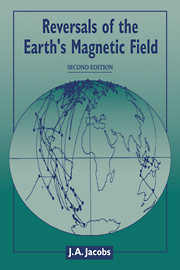Book contents
2 - The magnetization of rocks
Published online by Cambridge University Press: 23 September 2009
Summary
Introduction
Although most rock-forming minerals are non-magnetic, all rocks show some magnetic properties due to the presence of various iron oxide and sulphide minerals making up only a few per cent of the rock. These minerals occur as small grains dispersed through the magnetically inert matrix provided by the more common silicate minerals that make up most rocks. After the initial formation of the rock, subsequent weathering, diagenetic or metamorphic processes may produce iron oxides from these minerals, and such oxides may themselves carry a component of remanent magnetism which dates from the time of alteration.
When a rock forms, it usually acquires a magnetization parallel to the ambient magnetic field referred to as a primary magnetization. This can give information about the direction and intensity of the magnetic field in which the rock formed. However, subsequent to formation, the primary magnetization may decay either partly or wholly and further components may be added by a number of processes. These subsequent magnetizations are called secondary magnetization. The magnetization first measured in the laboratory is called the natural remanent magnetization (NRM). A major problem in palaeomagnetic investigations is to recognize and eliminate secondary components.
The mineralogy of rock magnetism is complicated by a multiplicity of phases and solid solutions of iron oxide, particularly with titanium dioxide. Most magnetic minerals are within the ternary systems FeO–Fe2O3 – TiO2. There are essentially two types of mineral: the strongly magnetic cubic oxides magnetite (Fe3O4), maghemite (γFe2O3) and the solid solutions of magnetite with ulvospinel (Fe2TiO4) known as titanomagnetite; and the more weakly magnetic, rhombohedral minerals based on hematite (αFe2O3) and its solid solutions with ilmenite (FeTiO3).
- Type
- Chapter
- Information
- Reversals of the Earth's Magnetic Field , pp. 35 - 58Publisher: Cambridge University PressPrint publication year: 1994



